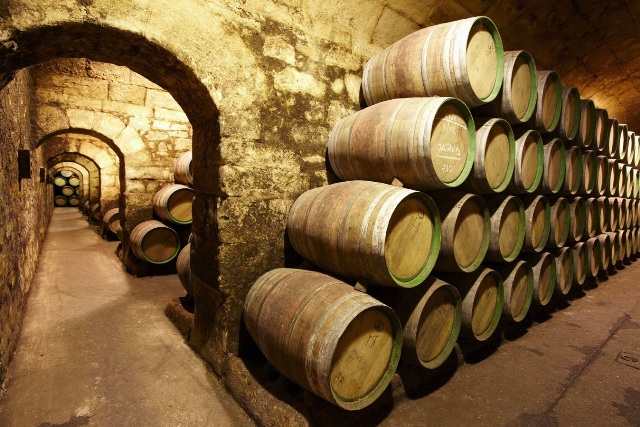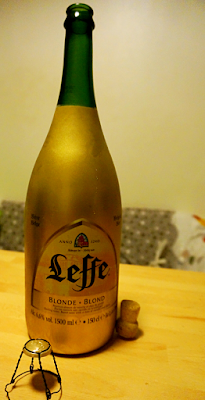This week we will expain you what Armagnac is, the differences between Armagnac and Cognac, and then present you one of the best armagnac "Bas Armagnac Dartigalongue 30 ans".
What is Armagnac?

Armagnac is a grape brandy from the Gascony region of southwestern France. Its closest relative is Cognac, another grape brandy from an appellation located about 100 miles north of Armagnac.
Even though it is related to and often confused with Cognac, Armagnac is very different with regards to its grapes, terroir, distillation, élevage, blending, aromas, tastes and textures. In truth, France's two finest brandies made from wine are not very much alike at all.
Armagnac Grapes
Armagnac, like all other types of brandy, is distilled wine. The
potent beverage is predominately made from the following grapes:
- Folle Blanche - These grapes are fickle and difficult to grow.
Those that do successfully grow this grape that is also highly
susceptible to rot and mildew find the vines offer a very low yield.
Because of the grape's difficult nature, only around 3% of vines in the
Gascony region are Folle Blanche.
- Ugni Blanc - These vines tend to be the easiest to grow and are therefore, the most widely planted grapes in the region.
- Colombard - This widely used grape provides fresh, young aromas to Armagnac.
- Bacco - This grape is a hybrid of the Folle Blanche and Noah grapes.
The AOC has determined that hybrid grapes cannot be used in the
production of Armagnac within the AOC regions after the year 2010.
Armagnac Regions
The Gascony region in France
is further divided into three main Armagnac producing regions:
- Bas-Armagnac - Armagnac produced in this region is made
predominately of Ugni Blanc and Bacco grapes. This region is said to
have the best soil, so it therefore produces the best Armagnac of the
three regions.
- Tenareze - This region is centrally located and the predominate
grapes used for Armagnac produced in Tenareze are Ugni Blanc and
Colombard.
- Haut-Armagnac - This region produces the lower quality Armagnac as compared to the other two regions.
Classification System
Just like Cognac, Armagnac has a similar classification system:
- Trois Etoiles - Armagnac bearing this label must be aged in wood
for a minimum of one year in France and a minimum of three years in the
United States and Great Britain.
- Very Special - Abbreviated simply as V.S. on the bottle, this Armagnac must be aged in wood for a minimum of two years.
- Very Superior Old Pale - This is also abbreviated to read V.S.O.P.
on the bottle and must be aged for a minimum of five years in wood.
- X.O. - Meaning extra old, this Armagnac has to stay in wood for at least six years before bottling.
- Hors d' Age - Armagnac with this label must be aged in wood for at least 10 years before bottling.
What's the Difference Between Cognac and Armagnac?
| Armagnac |
Cognac |
| Four primary grape varieties |
One primary grape variety (ugni blanc) |
| Usually distilled once in a continuous still. |
Distilled twice in pot stills. |
| Features vintages as well as blends |
Features more blends, few vintages |
| Is consumed more locally |
Is more an export product |
| VS = 1 year minimum |
VS = 2 years minimum |
| Often ages in local Gason oak barrels |
Ages in Limousin/Troncais oak barrels |
| Often distilled to lower proof ~57% |
Distilled higher ~70% |
| Grapes cost the same price whether from Bas Armagnac or Tenareze |
Grande Champagne grapes way more expensive than from other regions |
| More sandy soils in region |
More chalky soils in region |
| Allows for an unaged product "Blanche De Armagnac" |
Technically, no unaged variant permitted |
Bas Armagnac Dartigalongue
History
It was in 1838 during the reign of Louis Phillipe taht Pascal Dartigalongue, originally from Saint Lannes near Madiran, moved to Nogaro in the Gers and founded his maison d'Armagnac which is alive and well today. He very quickly realised that armagnac could be a successbul export product. Despite many difficulties he managed to send aok casks of armagnac to Bayonne where they would be shipped on to Holland And England.
In 1870 he acquired our present vineyard, "lacroutz", at Salles d'Armagnac (from which we have taken our brand name "Croix de Salles"). In about 1900 Joseph's son Henri took over the family business. It was at his time that Eau de vie officially became Know as Armagnac and acquired the appellation 'Jaune d'Or'. Thanks to the continuing expansion of the railways the trade in armagnac also continued to grow.
In 1930 Henri's very young son Pierre took on the responsibility of visiting their clients, first in France and later abroad. This initiative increased sales dramatically. In 1936, at the end of prohibition, he went to the USA and did some very good business with the Americans. After the end of the second world war he developed the sale of armagnac throughout Europe .
His son Jean-Pierre and his daughter Françoise now run the family business. They take pride in mainaining the century and half old family traditions of service and quality and living up to the family motto "My Armagnac, my strength".
Bas Armagnac Dartigalongue Extra 30 ans
Blend of several vintages aged from more than 30 years in oak barrels. Armagnac toned and shimmering deep amber. The palate is fresh , round and balanced. The flavors are deep and melted.
Tasting Notes:
NOSE : Very fruity nose,powerful and enjoyable. The nose reveals notes of candied orange, flowers, rancio and nuts.
PALLATE : Round and balanced with lots of freshness. It expresses notes of candied orange zest, peach, candied fruits and slight dried pineapple and spices with a beautiful woody note that give a subtle roundness in mouth.
FINISH : Beautiful, silky, long, powerful with aromas.
Age:
30 years
ABV:
40.0%
Award: Gold Outstanding
'Gold' Best French Wines & Spirits Asia 2013
Food Pairing:
Old armagnacs with guinea fowl and fruit, duck breast with honey, cep mushroom omelette …
Fruit based desserts: tarte tatin, pear charlotte, candied orange … chocolate desserts such as black forest gateau, chocolate mousse…
Special desserts such as an Armagnac Baba served alongside a 2cl glass of Armagnac, crepes with the liqueur Pousse Rapière…
The sweetness of the dessert softens the vivacity of the eau-de-vie.











































